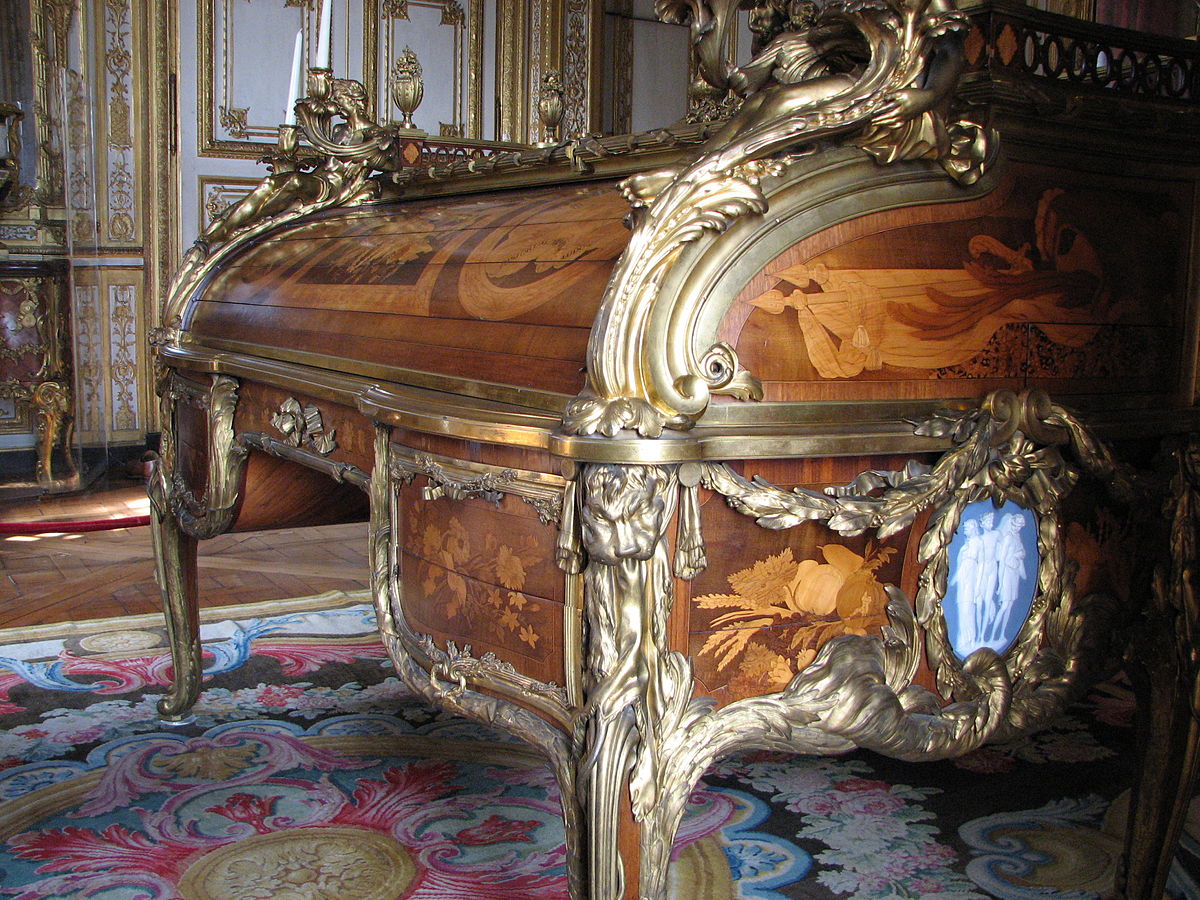Marquetry is the art of creating decorative designs and pictures by skillfully utilizing the grain, figure, and colors of thin veneers and sometimes other materials such as shells or ivory.
What is Marquetry?
Marquetry is the technique of inlaying wood or other natural materials to create a picture. Inlaying is to set a material onto another surface, but recessed in so that inlaid material is at the same level as the surface. The most used material for inlaying is wood but it could be ivory, mother-of-pearl, tortoise shells, bark, straw, stone, metal, gems. All the peculiarities, grain, knots, defects. Are used in the overall effect of the picture. Marquetry is often found on the finest furniture. It has been around for thousands of years, and today is considered something of a dying art.
Marquetry depending on how one defines was practiced in Egyptian and Roman times. It was widely used for the rich in the 17th, 18th, and 19th centuries in Europe.
When was veneered marquetry invented and diffused?
The veneered inlay technique finds inspiration in 16th century Florence. The work called opere di commessi, has medieval correspondences in “Cosmati” of Central Italy work of floors, altars, and columns in inlaid marble. In Florence, the Chapel of the Medici in San Lorenzo is covered with a colored marble covering with a particular saw technique.

image source: https://www.theflorentine.net/2019/01/02/medici-chapels/
At the beginning of the 16th century, wood marquetry techniques were discovered in Antwerp and other Flemish cities. The technique was imported to France after the mid-17th century. The inlay was employed by the royal manufactory of the Gobelins to create luxury furniture to decorate Versailles and other royal residences of Louis XIV. The first French inlay masters were the Flemish Pierre Golle and his son-in-law, André-Charles Boulle, who founded a dynasty of royal and Parisian cabinetmakers (ébénistes) and gave his name to an inlay technique that used tortoiseshell and brass with pewter in arabesque or intricate foliate motifs. The Boulle marquetry fell out of favor in the 1720s but was revived in the 1780s. In the 1750s floral inlay became popular in Parisian furniture, employed by cabinetmakers such as Bernard van Risenbergh, Jean-Pierre Latz, and Simon-François Oeben. The most famous French royal furniture veneered with inlays are the pieces delivered by Jean Henri Riesener in the 1770s and 1780s. The Bureau du Roi was the most famous of these celebrated masterpieces.
Who was André-Charles Boulle?
The J. Paul Getty Museum owns several fine examples of marquetry, including works by André-Charles Boulle (1642–1732).
In 1672, the artist grew from master cabinetmaker to ébéniste du Roi, royal cabinetmaker and sculptor of King Louis XIV. That same year, the king gave him the royal privilege of residence in the Palais du Louvre. This position enabled Boulle to produce furniture as well as works in gilt bronze, such as chandeliers, wall lights, and mounts for furniture. Although strict guild rules usually prevented craftsmen from practicing two professions simultaneously, Boulle’s favored position allowed him to pursue both. His specialty was wood pictorial marquetry, and he was so talented he became known as a “painter in wood.”
André-Charles Boulle never signed its creations. For this reason, several of Boulle’s marquetry objects are noted as “attributed to André-Charles Boulle” in the J. Paul Getty Museum collection.
What is The Bureau du Roi?
The Bureau du Roi, also known as Louis XV’s roll-top secretary, is the decorated cylinder desk built at the end of Louis XV’s reign.
The work presumably started in 1760. Its first designer was Jean-François Oeben. The first step was the fabrication of an extremely detailed miniature model in wax. The desk was completed in 1769 by Jean Henri Riesener. The project was to placed it in the new Cabinet du Roi at the Palace of Versailles. Later, it was transferred to the Louvre Museum in Paris after the French Revolution. In the 20th century, it returned to the Palace of Versailles and was placed in the same room where it was before. Secret diplomatic papers were kept inside the secretary’s secret drawers.

Image source: https://en.wikipedia.org/wiki/Bureau_du_Roi#/media/File:Bureau_du_roi,_cot%C3%A9_droit_et_face_avant.jpg
The desk has intricate marquetry decorations of various fine woods. A particular decoration element is the marquetry head of Silence, with forefinger to lips, a reminder of the discretion needed in the king’s business. The original design had a Louis XV miniature bust on top, that was replaced by Minerva after the king’s death in 1770.
Who was Jean-François Oeben?
Oeben was born in Germany but emigrated to Paris in the 1740s. After marrying the sister of another ébéniste, he was given the prestigious title of ébéniste du Roi (cabinetmaker to the king) in 1754 and obtained lodgings and a workshop at the Gobelins Manufactories. He later was assigned at the Arsenal in Paris, where he could build a forge to cast his metal fixtures. Oeben soon specialized in small, elaborated appliances, multi-purpose pieces of furniture with mechanical parts. He is also credited with having reintroduced naturalistic floral marquetry, which had fallen out of fashion. He produced furniture for the most fashionable members of the aristocracy and was patronized by Madame de Pompadour, Louis XV’s mistress. Oeben executed his work with considerable artistic taste and was an innovator in the use of intricate compositions, which is evident in the Getty Museum’s Writing and Toilette Table, from about 1754.
Info sources:
rts/a/masters-of-marquetry-in-the-17th-century-boulle
